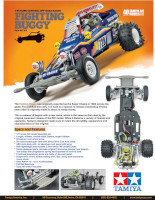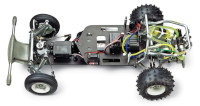

 The Fighting Buggy sure was hard to find. It all started with the first Tamiya buggy on the first SRB chassis, the 58015 Rough Rider in 1979. Other models on the same chassis would follow, but by 1982 the chassis had evolved into the 58034
Super Champ. The buggies were very similar in style and shared
much of the same chassis, but the rear end of the Super Champ switched
from torsion bar suspension to the verbosely named F.F.P.D.S.
(Free Floating Progressive Damping Suspension). This is a fancy
way of saying that the rear axles share a single shock with a
progressively wound (non-constant pitch) spring. Re-releases would
follow decades later. The Rough Rider became the 58441
Buggy Champ in 2009, then was released again as silver, gold, and RTR
versions in 2011. The Super Champ became the limited edition 84389
Fighting Buggy in 2014. It was apparently more popular than
expected and stock must have run out, because it was released with
another limited edition number only a year later: 47304.
None were in production at the time I was looking, but I was able to
find the most recent version by paying a lot of money for it and having
it imported from Japan. Another production run became available in 2021, long after I'd blown my fortune on mine.
The Fighting Buggy sure was hard to find. It all started with the first Tamiya buggy on the first SRB chassis, the 58015 Rough Rider in 1979. Other models on the same chassis would follow, but by 1982 the chassis had evolved into the 58034
Super Champ. The buggies were very similar in style and shared
much of the same chassis, but the rear end of the Super Champ switched
from torsion bar suspension to the verbosely named F.F.P.D.S.
(Free Floating Progressive Damping Suspension). This is a fancy
way of saying that the rear axles share a single shock with a
progressively wound (non-constant pitch) spring. Re-releases would
follow decades later. The Rough Rider became the 58441
Buggy Champ in 2009, then was released again as silver, gold, and RTR
versions in 2011. The Super Champ became the limited edition 84389
Fighting Buggy in 2014. It was apparently more popular than
expected and stock must have run out, because it was released with
another limited edition number only a year later: 47304.
None were in production at the time I was looking, but I was able to
find the most recent version by paying a lot of money for it and having
it imported from Japan. Another production run became available in 2021, long after I'd blown my fortune on mine.Let's talk about the naming convention. The Rough Rider became the Buggy Champ which would make it seem like the "champ" name came in later. However, the Super Champ became the Fighting Buggy so the "champ" was removed over time here instead of added. The advertisement at the left shines a little light on this. Apparently the names were different in Japan than for export. The Super Champ was always called the Fighting Buggy in Japan, so the re-release just brought the name up to date. Why were they different in the first place? Who knows.
The most distinctive feature of the Super Champ / Fighting Buggy is the rear suspension described above. In addition to the transverse shock, the thing you can see immediately is the rear mounted shock oil bottle. This effectively serves as a huge volume reservoir. It actually works pretty well in providing smooth damping. The tiny front shocks also use oil, but have so little volume by comparison that they are much less effective. By sharing a single rear shock, the rear suspension arms are not entirely independent. The shock serves as sway bar of sorts. The other change to the SRB chassis is the removal of the transparent water resistant radio box which has been replaced by an upper chassis plate. This results in some extra bending rigidity for the chassis. The upper plate must be removed to access the battery compartment. The re-re has been updated to accept a Tamiya Li-Fe battery, but those are impossible to get in the USA. I am using a small (1300 mAh) Li-Po instead.
Despite the age, front trailing arm and rear swing arm suspension, and locked differential, this thing still drives really well both on and off road. Much better than I would have predicted, in fact. I had previously built the SRB based Sand Scorcher which is less stable, but that's probably because of the relatively large and heavy body. The Fighting Buggy, by contrast, is very stable and even jumps well. I'm not going to treat it too roughly though.
Update: This model was destroyed in the 2022 fire. It has not been replaced.
 Page 1: Assembly |
 Page 2: Upgrades! |
 Page 3: Final Photos |